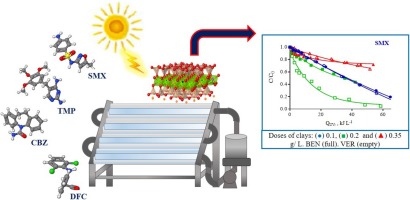Catalysis Today ( IF 5.3 ) Pub Date : 2018-07-07 , DOI: 10.1016/j.cattod.2018.07.021 J.I. Martínez-Costa , M.I. Maldonado Rubio , R. Leyva-Ramos

|
This study was aimed at evaluating bentonite (BEN) and vermiculite (VER) clays as photoactive materials for photodegrading a low-concentration (100 μg L−1) mixture of four emerging contaminants (ECs): trimethoprim (TMP), sulfamethoxazole (SMX), carbamazepine (CBZ) and diclofenac (DCF), using a solar advanced oxidation process. The experiments were performed in a stirred magnetic batch reactor (SMBR) and a solar pilot plant compound parabolic collector (CPC). The effect of mass, type of catalyst clay and H2O2 dose were evaluated, and the photodegradation of ECs was followed by Ultra Performance Liquid Chromatography (UPLC) and Dissolved Organic Carbon content (DOC). The results showed that the optimal dose of clays for EC degradation in both SMBR and CPC reactors was 0.2 g L−1. The photodegradation of ECs at optimal conditions by BEN and VER in the CPC decreased in the following order: DCF > TMP > SMX > CBZ and DCF > SMX > TMP > CBZ, respectively. The photodegradation rate constants for VER were 2, 32 and 1.1 times higher than those for BEN when SMX, CBZ and DCF were photodegraded with the optimal dose of clay, correspondingly. The percentage removal of DCF and SMX in experiments using BEN or VER was similar to TiO2. The TMP, SMX, CBZ and DCF degradation rate constants increased 9.05, 18.9, 2.08 and 23 times by adding [H2O2] = 200 mg L−1 and VER. The percentage removal of DOC was 16, 40 and 48% when VER and 50, 100 or 200 mg L−1 of hydrogen peroxide were added into the system, respectively. Similar results were obtained by adding BEN.
中文翻译:

膨润土和ver石在太阳能复合抛物面捕集器上降解新兴污染物双氯芬酸,磺胺甲恶唑,甲氧苄啶和卡马西平
这项研究旨在评估膨润土(BEN)和ver石(VER)粘土作为光敏材料的光降解四种新兴污染物(EC)的低浓度(100μgL -1)混合物:甲氧苄氨嘧啶(TMP),磺胺甲恶唑(SMX) ,卡马西平(CBZ)和双氯芬酸(DCF),采用太阳能高级氧化工艺。实验是在搅拌式磁力间歇反应器(SMBR)和太阳能中试厂复合抛物线收集器(CPC)中进行的。催化剂粘土的质量,类型和H 2 O 2的影响评估剂量,然后用超高效液相色谱(UPLC)和溶解有机碳含量(DOC)跟踪EC的光降解。结果表明,SMBR和CPC反应器中用于EC降解的粘土的最佳剂量为0.2 g L -1。在最佳条件下,CPC中的BEN和VER对EC的光降解顺序依次为:DCF> TMP> SMX> CBZ和DCF> SMX> TMP> CBZ。当用最佳剂量的粘土对SMX,CBZ和DCF进行光降解时,VER的光降解速率常数分别比BEN高出2、32和1.1倍。使用BEN或VER的实验中DCF和SMX的去除率与TiO 2相似。通过添加[H 2 O 2 ] = 200 mg L -1和VER ,TMP,SMX,CBZ和DCF降解速率常数分别提高了9.05、18.9、2.08和23倍。当将VER和50、100或200 mg L -1的过氧化氢分别添加到系统中时,DOC的去除百分比分别为16%,40%和48%。通过添加BEN可获得相似的结果。



























 京公网安备 11010802027423号
京公网安备 11010802027423号